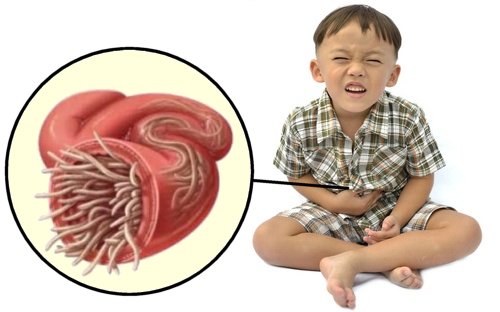
The intestinal infestation of parasites is common in children. It is more common in underdeveloped countries like Bangladesh. A Parasite is a small organism or living animal that stays and gets nourishment from another animal, called the host. The human being is a host. When it takes its food from the host, the host suffers. A parasite can not live by itself. The intestinal parasite lives inside the gut. The intestinal parasites are usually the protozoa or worms. It spreads very easily in crowded places. Poor sanitation, unsafe water, barefoot, unhygienic habit increases the risk of parasitic infestation.

Also, note that all family members must be treated together. A single tablet of Albendazole 400mg can be taken by all adult members.
What is the most common parasitic infection?
The answer varies among countries. Giardia is common in North America. In Bangladesh, Ascariacis is more common.
Common Signs of Parasite Infection?
- Abdominal pain
- Fever sometimes
- Nausea, vomiting
- Lethargy
- Flatulence
- Abdominal distension, gas, or bloating.
- Weight loss
- Diarrhoea or dysentery
- Loss of appetite
- Other systemic symptoms
How does a baby get a parasite?
Children of all ages can develop parasitic diseases such as giardiasis and cryptosporidiosis from swallowing contaminated water during swimming, playing, and other activities in contaminated water (e.g. pools, fountains, lakes, rivers and streams, etc.), contact with contaminated faeces, poor sanitation, poor hygiene.
Common Intestinal Parasites
- Amoebiasis
- Giardiasis
- Ascariasis
- Enterobiasis
- Ankylostomiasis
Amoebiasis
Caused by: Entamoeba histolytica.
Route of transmission: Faeco-oral route.
Causes:
1. Amoebic colitis, abdominal pain, diarrhoea, dysentery.
2. Amoebic liver abscess, metastasis to other organs like lung, brain, spleen, skin ( Pretty scary)
Investigations: 1. Stool RME will show trophozoites
Treatment:
- Metronidazole (Flagyl, filmet, amodis): 35-50mg/kg/day – 8 hourly for 10 days
- Tinidazole (T-zol): 50mg/kg/day once daily for 3-5 days.
- Nitazoxanide (Zox, nitazox): 15 mg/kg/day for 3 days.
Giardiasis
Caused by: Giardia intestinalis
Route of transmission: Faeco-oral route.
Causes:
- Malabsorpsion syndrome
- Reiters syndrome
- Reactive arthropathy
- Deficiency of vitamin A, B12
- Lactose intolerance
Investigations: 1. Stool RME will show trophozoite or cyst
Treatment:
- Metronidazole (Flagyl, filmet, amodis): 35-50mg/kg/day – 8 hourly for 10 days
- Tinidazole (> 3 years) (T-zol): 50mg/kg/day once daily for 3-5 days.
- Nitazoxanide (Zox, nitazox): 15 mg/kg/day for 3 days.
Easy dosage guideline for nitazoxanide:
1 year to 3 years: 100mg 12 hourly
3 to 12 years: 200 mg 12 hourly
12 years: 500mg Tab 12 hourly
Ascariasis
Caused by: Ascaris lumbricoides
Route of transmission: Faeco-oral route.
Causes:
- Malabsorpsion syndrome
- Nutritional deficiency
- Intestinal obstruction
- Acute Appendicitis
- Acute cholecystitis
- Allergic reactions
Investigations: 1. Stool RME
Treatment:
Anthelmintics Dose:
Albendazole (Almex, Alben): <2 years: 200mg, >2 years: 400mg single dose, may repeat in 2 weeks
Pyrantel pamoate (Melphin, Delentin): 11mg/kg orally single dose
Levamisole (Etrax): 3mg/kg single dose
Mebendazole (Solas): 100mg 12 hourly 3 days
Enterobiasis
Caused by: Enterobius vermicularis
Route of transmission: Faeco-oral route.
Causes:
- Perianal pruritis at night.
- Loss of appetite
Investigations: 1. Presence of worm on the naked eye.
Treatment: Anthelmintics Dose:
Albendazole (Almex, Alben): 400mg single dose for all ages
Pyrantel pamoate (Melphin, Delentin): 11mg/kg orally single dose
Mebendazole (Solas): 100mg single dose for all ages
Ancylostomiasis
Caused by: Ancylostoma duodenalis or Nacator americanus
Route of transmission: penetration of skin when the child walks barefoot on contaminated soil.
Causes: This one literally drinks blood from your body.
- Anaemia due to blood loss
- Loffler’s Syndrome
Investigations: 1. The egg is visible in the stool.
Treatment: Anthelmintics Dose:
Albendazole (Almex, Alben): <2 years: 200mg, >2 years: 400mg single dose, may repeat in 21 weeks
Pyrantel pamoate (Melphin, Delentin): 11mg/kg orally single dose for 3 days
Levamisole (Etrax): 3mg/kg single dose
Mebendazole (Solas): 100mg 12 hourly 3 days
That’s all for now. Contact your paediatrician for more information and treatment guideline.
Leave a Reply